Categories
Left column house ads
Seen & Heard: Citibank’s Gaudy Advertising
October 20, 2017 Arts & Culture, Construction, Restaurant/Bar News, Services, Shopping
••• Citibank’s use of the windows at 120 W. Broadway for billboard-style advertising is tacky, obviously. But it’s also disrespectful for what is essentially a historic district. And the giant LED screen (in the second photo) is the worst.
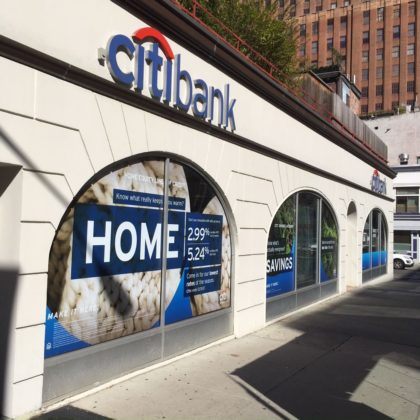
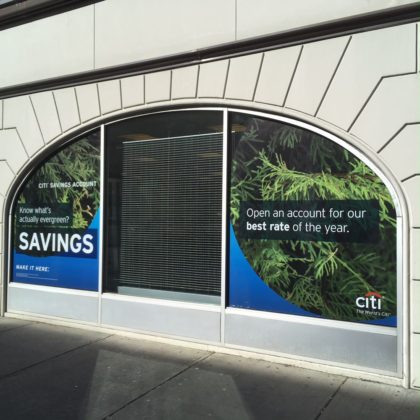 ••• “Deep below Tribeca’s streets… There was a candlelit Secret Supper.” That and the photo below are from Justin Breton on Instagram. I don’t know anything else about it, but copied on the post was Spring St. Social Society.
••• “Deep below Tribeca’s streets… There was a candlelit Secret Supper.” That and the photo below are from Justin Breton on Instagram. I don’t know anything else about it, but copied on the post was Spring St. Social Society.
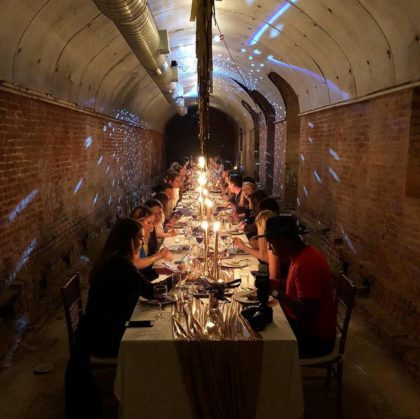 ••• Baxter & Liebchen sent out an email touting a “huge sale” this Saturday, with up to 80% off select items. The store doesn’t do that sort of thing very often, so I’d assume it’s meaningful.
••• Baxter & Liebchen sent out an email touting a “huge sale” this Saturday, with up to 80% off select items. The store doesn’t do that sort of thing very often, so I’d assume it’s meaningful.
••• High Violet LLC is shooting a “feature film” yesterday and today in the Greenwich/Desbrosses area.
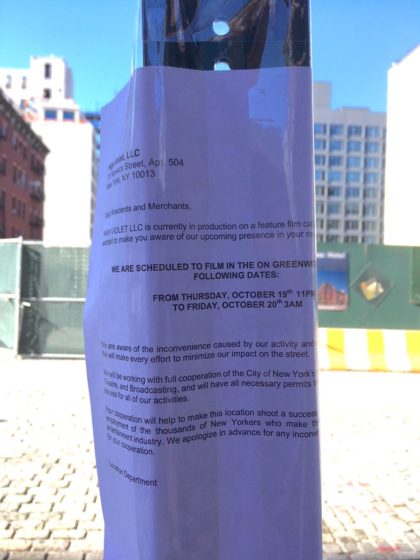 ••• Meanwhile, across the street, is the stalled hotel site at 456 Greenwich. I know people have seen activity there lately, but whenever I walk by, it’s dead as a doornail.
••• Meanwhile, across the street, is the stalled hotel site at 456 Greenwich. I know people have seen activity there lately, but whenever I walk by, it’s dead as a doornail.
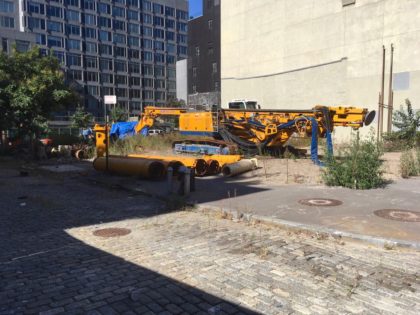 ••• Serafina is now serving breakfast.
••• Serafina is now serving breakfast.
••• I don’t know that I’ve seen this before. (At first I thought it was Abraham Lincoln.)
8 Comments
Comment:
Subscribe
Subscribe to the TC Newsletter




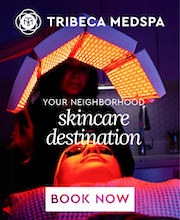









You are so right about Citibank. Its an assault on my senses.
1st rule of Secret Supper is not to talk about Secret Supper
Herman Munster!
Citibank will do whatever they want they pay the high rent which the landlords love all the big chains in our neighborhood that slowly faded away from being “original”
Absolutely right. That store was empty for a long time. I’d rather have Citibank than an empty store. I don’t hear anyone positioning local landlords to cultivate individuality and entrepreneurship with lower rents…
The CitiBank ads are horribly ugly.
Why doesn’t NYC limit size and placement of outdoor advertising?
https://www.theguardian.com/cities/2015/aug/11/can-cities-kick-ads-ban-urban-billboards
The City does quite a bit to regulate outdoor advertising, through the zoning resolution, but differently depending on whether the signage is “accessory” to the business on site or an advertising sign unrelated to its location. These bank signs in a commercially zoned district are arguably “accessory” to the bank that is on site, if oversized, and not “advertising signs” like billboards, but they likely exceed the size limits.
Separately, the fact that the City often does not rezone legacy manufacturing (like Soho) and commercial districts (I recall this bank is in a C6 district) that through gentrification have become residential means that the regulation may have limited effectiveness in certain areas.
http://www.citylandnyc.org/signs-and-billboards-whats-legal-and-whats-not/
“The Zoning Resolution’s rules differ depending on whether a sign is accessory to the business at that location, or is an advertising sign. An advertising sign, as defined in Zoning Resolution Article 1, Chapter 2, Section 12-10, directs attention to a business or product sold elsewhere that is not accessory to a use located on the zoning lot.
[…]
“The Zoning Resolution bans advertising signs from residential zoning districts, but allows for the limited installation of accessory signs.
[…]
“Illuminated accessory signs in residential districts are only authorized for hospitals and other health-related facilities. These signs, however, are not allowed to flash and must be limited to the lesser of 25 square feet per street frontage or 15 percent of such street frontage in feet.
[…]
“no sign in a residential district is permitted to extend beyond the street line by more than twelve inches or rise above the ceiling of the ground floor, or 20 feet above the curb level, whichever is lower
[…]
“Regulation of accessory and advertising signs is far more complicated in commercial districts. Accessory signs in commercial districts are limited by how high the sign may be affixed to a building, by how much it may project from the building, by how big it may be in relation to the lot’s street frontage, and by illumination restrictions. Generally, the greater a building’s street frontage, the larger an accessory sign that will be allowed.
“Advertising signs, on the other hand, are allowed only in C6-5, C6-7, C7, and C8 commercial districts and not allowed at all in the other commercial districts. Since both accessory and advertising signs are permitted in these four commercial districts, the distinction between the two signs is less important than in C1 through C6 commercial districts where advertising signs are prohibited. In C1 through C6 commercial districts, a legally conforming sign could be rendered illegal simply by changing the content of the sign from advertising one’s own business to advertising the business of another.
[…]
“Manufacturing districts impose less restrictive regulations upon accessory and advertising signs than do residential or commercial districts. The three manufacturing districts (M1, M2, and M3) generally allow both accessory and advertising signs, with a maximum sign surface area for each zoning lot based upon the lot’s street frontage.
[…]
“Since 1940, New York City has banned advertising signs (i.e., billboards) within 200 feet of an arterial highway, and within view of a public park of one-half acre or more. Accessory signs in residential, commercial, and manufacturing districts, however, are allowed within 200 feet of an arterial highway or within view of a public park, but must be reduced in size.”
Here is the relevant text from the zoning resolution for the sizes of these Citibank signs. They filed the illuminated “citibank” words above the windows with DOB, but I see no permits for the window (non-illuminated) signage.
If you go measure Citibank’s frontage and window signage at 120 West Broadway and you think there is reason to complain about the total size facing each street of the non-illuminated window signs to 311 either by phone or online, I suggest you cite the sections 32-642 and 32-64 of the zoning resolution below.
ZR 32-642 Non-illuminated signs
C1 C2 C3 C4 C5 C6 C7 C8 In all districts, as indicated, non-#illuminated signs# with total #surface areas# not exceeding those shown in the following table are permitted:
[…]
C4 C5-4 C6-1 C6-2 C6-3 C6-4 C6-6 C6-8 C6-9
Five times the #street# frontage of the #zoning lot# (in feet), but in no event more than […] 500 sq. ft. on each frontage for #corner lots#.
To calculate the applicable street frontage of the zoning lot, see:
ZR 32-64 Surface Area and Illumination Provisions C1 C2 C3 C4 C5 C6 C7 C8 […]
For the purpose of determining permitted #surface area# of #signs# for #zoning lots# occupied by more than one establishment, any portion of such #zoning lot# occupied by a #building# or part of a #building# accommodating one or more establishments on the ground floor may be considered as a separate #zoning lot#
[This means the frontage used for calculating the maximum signage area is limited to that of that particular store itself, even if it is part of a larger building.]
Note: 32-644 Illuminated or flashing signs in C4, C5-4, C6 or C7 Districts
C4 C5-4 C6 C7 In the districts indicated, #illuminated# or #flashing signs# with total #surface areas# not exceeding those shown in the following table are permitted: District Maximum Surface Area (in square feet) C4 C5-4 C6-1 C6-2 C6-3 C6-4 C6-6 C6-8 C6-9
Five times the #street# frontage of the #zoning lot# (in feet), but in no event more than […] 500 square feet on each frontage for #corner lots#.